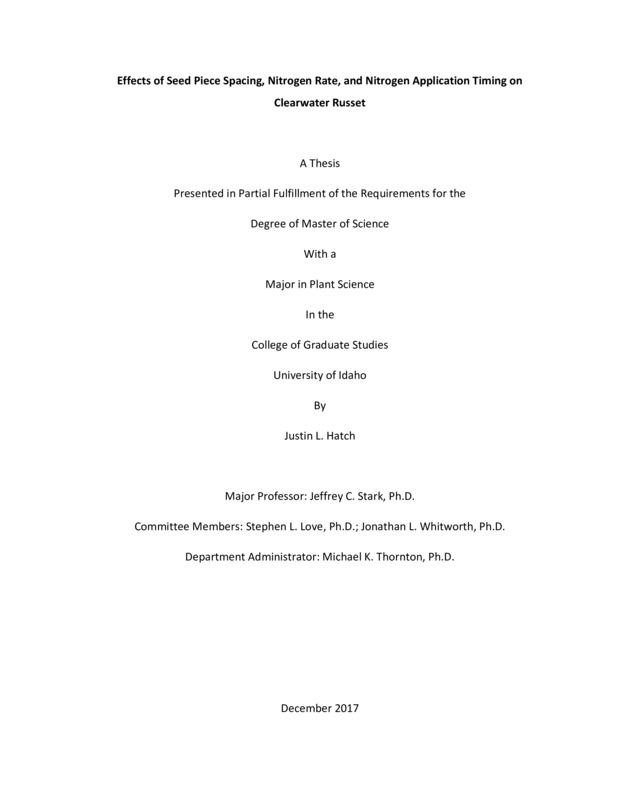Effects of Seed Piece Spacing, Nitrogen Rate, and Nitrogen Application Timing on Clearwater Russet
Hatch, Justin Lorin. (2017-12). Effects of Seed Piece Spacing, Nitrogen Rate, and Nitrogen Application Timing on Clearwater Russet. Theses and Dissertations Collection, University of Idaho Library Digital Collections. https://www.lib.uidaho.edu/digital/etd/items/hatch_idaho_0089n_11242.html
- Title:
- Effects of Seed Piece Spacing, Nitrogen Rate, and Nitrogen Application Timing on Clearwater Russet
- Author:
- Hatch, Justin Lorin
- Date:
- 2017-12
- Program:
- Plant, Soil and Entomological Sciences
- Subject Category:
- Agronomy; Plant sciences
- Abstract:
-
Clearwater Russet, a new potato variety, released by Northwest Potato Variety Development Program, has garnered favor among producers and processing industries. The objectives of this study were to identify the optimum combination of nitrogen (N) fertilizer rate, N application timing, and seed piece spacing to produce maximum economic returns for this variety. Investigated seed piece spacing’s were 25 and 33 cm in 91 cm-wide rows, combined with three N rates, 0, 202, and 269 kg N/ha, and two N application timings; consisting of either 2/3 of N applied prior to tuber initiation (early-loaded) and 1/3 after tuber initiation, or 1/3 of N applied prior to tuber initiation and 2/3 after tuber initiation (late-loaded). Post-harvest assessment of treatments included measurements of total yield, U.S. No 1 yield, tuber size distribution, tuber specific gravity (SG), and economic fry returns. Petioles were analyzed to assess effects of N management on plant NO3 –N levels. In-season whole plant sampling was conducted to identify tuber density (tubers per unit area), plant N accumulation, and DM partitioning. The 25 cm spacing treatment produced higher total yield, and accumulated more DM, and N in tubers than the 33 cm spacing treatment. However, the economic return for the 33 cm spacing treatment was 11% greater than the 25 cm treatment due to greater yields of large (>397 g) tubers and a higher percent of U.S. No. 1’s. The 33 cm spacing produced fewer tubers and stems per unit area. Petiole NO3- N was positively correlated with N rate and timing. Nitrogen applications, especially when applied early, increased yield of large (>397 g) tubers, reduced the yield of small (114-170 g) and undersized tubers (<114 g). High N rates applied early in the season significantly increased vine DM and N accumulation, while reducing tuber DM and N accumulation. The early-loaded 202 kg/ha N treatment produced the highest economic return. Although the early-loaded 269 kg/ha N treatment resulted in a similar economic return. The results of this study indicate that N rates for Clearwater Russet should be about 25% less than recommended N rates used for Russet Burbank, with 2/3rds of N applied prior to tuber initiation. Seed piece spacing of 33 cm, in 91 cm-wide rows should produce higher economic fry returns than narrower spacing, when size incentives are offered for large tubers.tuber initiation) provided the best economic return.
- Description:
- masters, M.S., Plant, Soil and Entomological Sciences -- University of Idaho - College of Graduate Studies, 2017-12
- Major Professor:
- Stark, Jeff C
- Committee:
- Love, Stephen L; Whitworth, Jonathan L
- Defense Date:
- 2017-12
- Identifier:
- Hatch_idaho_0089N_11242
- Type:
- Text
- Format Original:
- Format:
- application/pdf
- Rights:
- In Copyright - Educational Use Permitted. For more information, please contact University of Idaho Library Special Collections and Archives Department at libspec@uidaho.edu.
- Standardized Rights:
- http://rightsstatements.org/vocab/InC-EDU/1.0/

